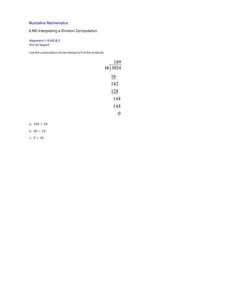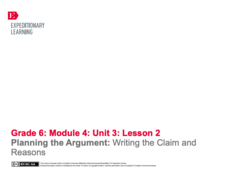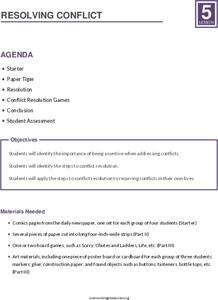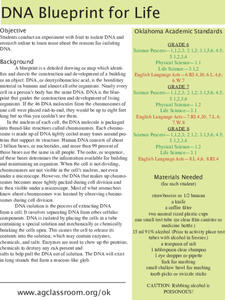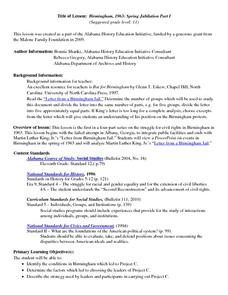Curated OER
Stay Focused on Long Division
Students utilize a checklist in order to help them stay focused on long division problems.
Curated OER
Long Division Examples and Practice
In this math worksheet, students are given 2 examples of long division and the steps involved. Students are asked to solve 4 division problems using the methods in the examples.
EngageNY
The Long Division Algorithm
Two methods are always better than one! The eighth installment in this series asks pupils to convert decimals to fractions using two approaches. Individuals first use the more traditional approach of long division and then use reverse...
Curated OER
Side-By-Side Division Algorithms
Show classes how to work their way through the algorithms. The long division lesson plan shows five algorithms in dividing multi-digit numbers by a single digit. The algorithms include partial quotients, stacking method, place value long...
Illustrative Mathematics
Interpreting a Division Computation
Mathematicians show their understanding of a division problem. If a student can apply long division to a pair of numbers and determine a quotient, what other factors and multiples become apparent? The example illustrates a simple...
EngageNY
The Euclidean Algorithm as an Application of the Long Division Algorithm
Individuals learn to apply the Euclidean algorithm to find the greatest common factor of two numbers. Additionally, the lesson connects greatest common factor to the largest square that can be drawn in a rectangle.
Virginia Department of Education
Modeling Division of Fractions
Provide a meaningful context for learning about the division of fractions with this upper-elementary math lesson. Presented with a simple, real-world problem, young mathematicians work in small groups to develop visual models...
Curated OER
short Division
Fourth graders practice division through a timed test. In this short division lesson, 4th graders recognize the benefit of using short division. Students complete a short division worksheet.
EngageNY
Planning the Argument: Writing the Claim and Reasons
Step up! Using the resource, scholars discover the six steps to writing an effective position paper. Next, they work on a graphic organizer to begin planning their argument-based essays.
Florida Department of Environmental Protection
Water's Journey Expedition
Step into a scientist's shoes to go online and discover the Florida Springs Expedition, and participate in two activities focusing on how humans impact the environment. The first activity asks scholars to summarize the six...
Overcoming Obstacles
Resolving Conflict
Win-lose, lose-lose, or win-win? The final lesson in the "Resolving Conflict Module" brings together all that participants have learned in the module. They first list and prioritize the steps in conflict resolution, then develop a plan...
Curated OER
Data Analysis Challenge
In this data analysis worksheet, young scholars work with a partner to collect information for a survey. The information is then compiled into a graph. Students must indicate their survey question, the target audience, predict the...
Curated OER
Story of Silk
Students investigate the steps of the silk-making process through a reading of the story, "The Empress and the Silkworm" by Toy Hong. Sequencing cards are utilized to enhance the process and a silkworm's cocoon is unravelled.
Curated OER
DNA Blueprint for Life
Did you know that meat tenderizers contain DNA cutting enzimes? Did you know that you can isolate your own DNA? Or the DNA of fruit? Explore with your learners the DNA world with a series of experiments using readily available materials...
Curated OER
The Maccabees and Their Place in Jewish History
Learners assume the role of a journalist employed by time Warner to examine data about the long-lost cave contining the tombs of Maccabees. A two page spread is created for the weekend edition of the magazine.
Curated OER
What's New With Dinosaurs?
Young scholars examine how scientists are at odds on whether or not dinosaurs were warm or cold blooded. In this dinosaurs lesson students divide into groups and research the evidence that supports each side.
Curated OER
Expository --Writing
In this writing worksheet, students investigate the writing process, especially in expository articles. Students examine a piece written for a children's magazine about dinosaurs. Students read about the steps taken to generate it:...
Alabama Department of Archives and History
Birmingham 1963: Spring Jubilation Part 1
As part of a study of the 1963 quest for civil rights in Birmingham, Alabama, class members view a PowerPoint that details the struggle and analyze Martin Luther King, Jr.'s "Letter from a Birmingham Jail."
Curated OER
3-2-1 Pop!
Students investigate how rocket liftoff demonstrates Newton's Laws of Motion. They participate in a class discussion, and construct a rocket powered by the pressure generated from an antacid tablet reacting with water.
Curated OER
Active Viewing: Savage Acts
Based on the documentary film Savage Acts: Wars, Fairs, and Empire, this lesson explores concepts of National interests and imperialism. They view sections of the film and share which images exemplify the meaning of each vocabulary term....
BW Walch
“Outsider” Poet Kay Ryan Goes from Poetry Club Reject to Poet Laureate
The cat might have got your tongue, but you can’t avoid the elephant in the room while you wait for the other shoe to drop. After all, the early bird gets the worm and the chickens are circling. After researching Poet Laureate Kay Ryan...
Willow Tree
Weighted Averages
Mixtures, weighted percentages, and varying speeds make problem solving difficult. The resource give learners a strategy for tackling these types of problems effectively.
Rainforest Alliance
My Forest or the Rainforest?
The differences between tropical and temperate rainforests range from animals and flowers to climate and landscapes. Kindergarteners compare and contrast characteristics of their local forest to a tropical rainforest.
West Contra Costa Unified School District
Solving Inequalities
What does translating points on a number line have to do with solving inequalities? Young mathematicians first learn about translations of points on a number line, and then use this information to solve linear inequalities in one variable.




